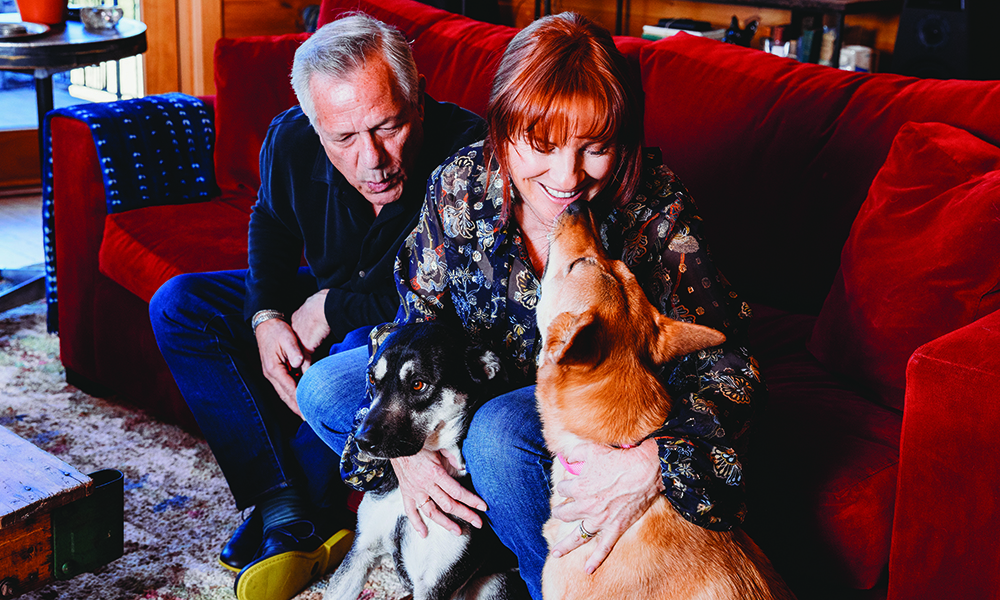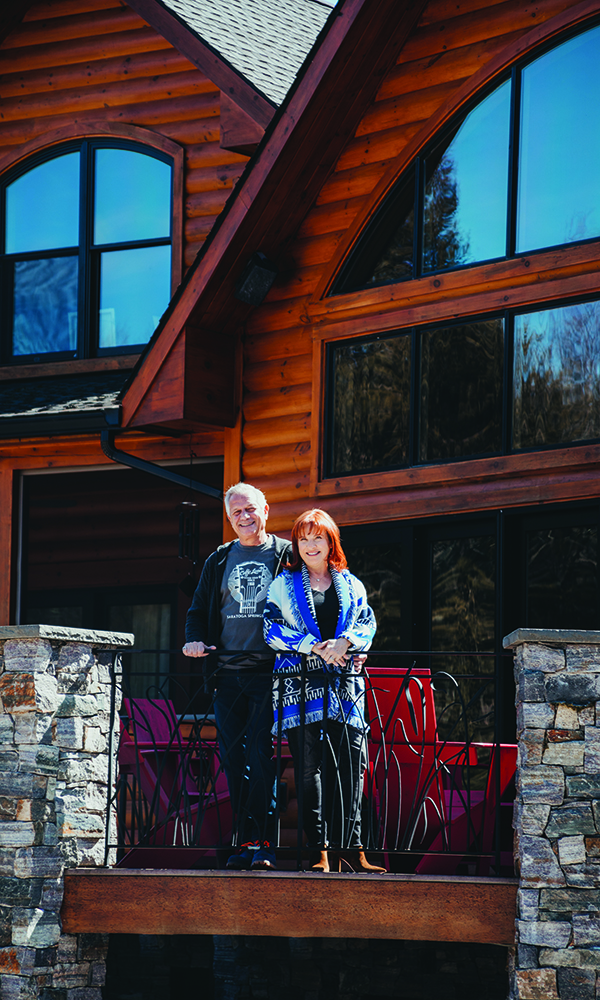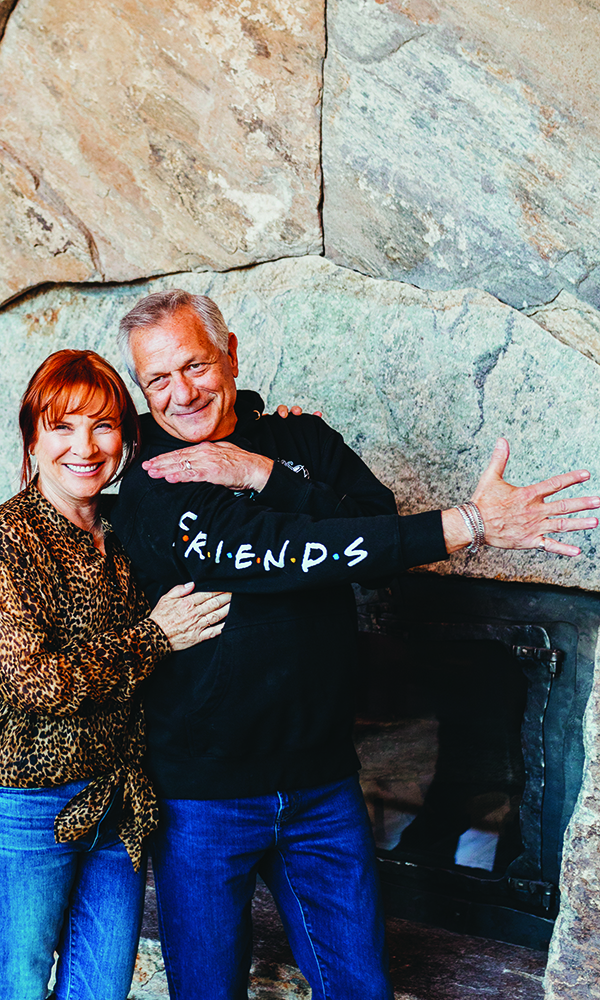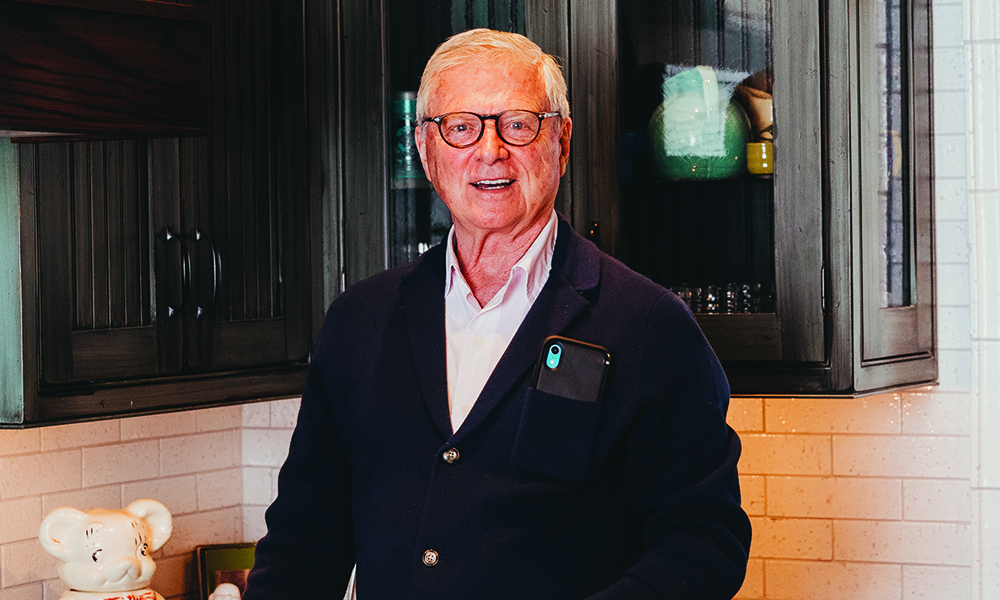By no means would I ever compare myself to legendary scribe and father of New Journalism Gay Talese. But as this cover story—on Emmy Award-winning Executive Producer and Director of hit NBC sitcom Friends, Kevin Bright, and his wife, Claudia Wilsey Bright—was coming to fruition during very uncertain times, I had Talese’s tour de force, “Frank Sinatra Has a Cold,” on my mind. Mid-March, even as I took off from Troy on a brisk, sunny morning to interview the couple at their Saratoga area home, it was my battle cry of sorts.
That famous article first appeared in Esquire magazine in April 1966, a once-in-a-lifetime journalistic feat rooted in the notion that, even if you are unable to reach the subject you’ve been sent out to cover—in Talese’s case, it was an uncooperative Frank Sinatra who was in the throes of a throaty cold, feeling his age and by no means in good spirits—you as a journalist have the responsibility to tell the story anyway. Instead of giving up on the assignment, Talese interviewed a number of Sinatra’s acquaintances, inner-circle types and hangers-on—even Sinatra’s own mother!—and weaved it all into a noir-y, third-person omniscient narrative, that weighs in at a respectable 15,000 words.
The Brights are some of the loveliest people I’ve ever met, so I wasn’t comparing them to Old Blue Eyes. But there was definitely, unequivocally “a cold” brewing that came awfully close to making sure I never got to know them at all.

At the beginning of March, I’d reached out to the Brights about capturing their story (and photographs) at their rustic, log cabin home for Saratoga Living’s Design Issue cover story—and they almost immediately said yes. But just 10 days later, on the eve of our photo shoot, I received the following note from Kevin (edited only slightly for punctuation and clarity): “Obviously, none of us planned for the world to be in chaos when we booked this photo shoot. I really want as few people here as possible, and I will request people take their temperature before coming in and I will want to know there has been no contact to a known carrier.”
Yes, the COVID-19 pandemic was upon us. Would I arrive at his house just to be turned away? As I write this, I’m quite a few weeks into quarantine, and it’s hard to remember those early days. The day Bright sent me that missive, though, New York Governor Andrew Cuomo had temporarily shut down restaurants, bars, casinos, movie theaters, gyms and other communal-gathering-type businesses, and implored employers to let nonessential employees work from home, in an attempt to stop the virus’ spread. Maybe it sounds insane now, but as soon as I received Bright’s email, I made up my mind, then and there, to confirm the next day’s photo shoot. It was Saratoga that had the “cold,” and damn the torpedoes, I was going to tell the Brights’ amazing story.
None of us knew then how much that day would end up meaning to all involved. Beginning that evening, we would all go into indefinite self-isolation, wistfully looking back at that time we spent at the Brights’ house, working and laughing and conversing with other humans (almost) like it were any other day.

To truly understand the sheer magnitude of the Brights’ Saratoga area estate, one must be intimately familiar with the marvelous mansions of North Broadway, the castle-like Victorians of Union Avenue and even some of the Brobdingnagian new constructions that now dot our city. As a child, I had a number of chances to run around inside some of those palatial homes. Many of them have multiple, cavernous rooms; extravagant interior and exterior designs; and lush, sloping lawns, which are tended to like golf courses during the summer months. In a word, they’re wonders of the design world. The Brights’ property, however—which has been in Claudia’s family for seven generations—makes these residences look like fifth-grade dioramas. In all, it covers, give-or-take, 400 acres in total area. (For privacy purposes, I won’t be disclosing its exact location.) Turning up the Brights’ stone gravel driveway, you’re immediately met by just how vast their property truly is. You pass through a gate with a “Queens Highway” sign on it, and there’s a massive pond to your right, with a floating dock smack-dab in the middle and a silver airstream-like trailer on its shores. Soon, you find yourself in the middle of a lush, verdant forest, before it gives way into a clearing, where you first see the Brights’ breathtaking lawn, which cascades down from their front porch like a river of green. “My ancestors are all here, and I feel the power of them when I’m here,” says Claudia of the property. “My parents lived here, my brother and sister live here, and we would bring our kids here in the summer for a few weeks. One of [my sons] actually now lives in the area, and the other one was just married out there [she gestures towards the front lawn] in September. My connection to this, my upbringing here, keeps me grounded.”
When I referred to it as their “log cabin home,” I wasn’t joking. Claudia procured it from the aptly named Original Lincoln Logs of Lake George building firm, which had several models to choose from. “I wanted something that could go up fast,” she says. “We made a few tweaks—changed doors, pushed out some walls and things.” She then points, chuckling, at the home’s centerpiece, a behemoth fireplace built out of what can only be described as a jigsaw puzzle of boulders, which were craned in in the middle of the winter. “It looked like fragile rock; they had all these tarps up, cutting stone. It’s all Lake Champlain granite,” says Claudia. Kevin quickly interjects, correcting his wife. “She meant Fraggle Rock, not fragile rock; that would be a different danger to contemplate,” he says, tongue firmly in cheek. The couple moved in in 2009.
The rusticity of the home is amplified, tenfold, by its upscale design aesthetic, the majority of which is the handiwork of Edmond DeRocker (see below), who’s worked extensively on the Brights’ home and is currently embellishing other parts of their property, including picking up and moving an entire “party barn” onto another section of it. The main house is filled to the brim with pop culture memorabilia of all stripes, most of which is Kevin’s. There’s an original Janis Joplin concert poster from the Fillmore East’s opening night, framed and adorning the wall closest to the window overlooking the lawn; a tall, absurdist painting by actor/comedian Martin Mull, entitled October, which features a woman in marching band garb, in a rather seductive pose, in front of a quaint home, not unlike the Brights’ home itself; and a tin sign that appeared in the Friends coffeehouse, Central Perk (basically, the show’s Uncommon Grounds). He also has a basement full of pinball machines; ’50s drinking glasses; a photo signed by the late President Ronald Reagan; a felt campaign flag and metal pin from John F. Kennedy’s presidential campaign; a black-and-white framed original photo of heavyweight boxer Jack Johnson in Ballston Spa, standing next to what appears to be a Lilliputian; and a mini Farfisa organ that he had me test out (it works).

Shortly after the modest Saratoga Living contingent—that would be me, CEO Abby Tegnelia, Senior Photographer Dori Fitzpatrick and two stylists from Complexions Spa for Beauty & Wellness—gingerly walked through the front door of the Brights’ home (we were all trying to avoid touching things), I approached Kevin, who was sitting alone on a comfy red couch, and asked him if he wanted to start our interview. Unlike Sinatra, Bright immediately lit up, looking back fondly on his career and life, which I was there, seemingly, to pry into. I started off with an icebreaker. “When was the last time you laughed really hard?” I asked him. “The Curb Your Enthusiasm ‘MAGA hat’ episode,” he answered. “There were some very, very gut-wrenching laughs in that one.” The irony of his answer won’t be lost on the diehard Friends fan: Curb’s creator and star, Larry David, also was the co-creator of the the wildly popular TV sitcom Seinfeld, which pre-dated the airing of Friends by some five years. Its co-creator and lead actor, comedian Jerry Seinfeld hasn’t minced words about his feeling that Friends ripped off his show. (Bright says that he and co-creators Marta Kauffman and David Crane were blindsided by the accusation.) I then asked Bright why he thought Friends has become such a lasting hit, and he explained why, vis-à-vis a recent Saratoga anecdote. “I was eating in a local Japanese restaurant at the hibachi counter—where they usually stick two families together—and a little girl, about 10 or 12 years old, came and sat down next to me, and she had a Friends t-shirt on,” said Bright. “So I said to her, ‘I like your t-shirt,’ and she said, ‘Thank you.’ I asked if she watched the show. She said, ‘yes,’ it’s my favorite show.’ ‘Your favorite show?’ I said. ‘You know, that’s an old television show. Why would that be your favorite show?’ She looked at me like I was an idiot and said, ‘Because it’s funny.’ I think the thing about Friends that connects is that the show is about either a time of your life that you’re in or about to enter or have been in and have wonderful nostalgic memories about. It’s your twenties. There’s something real about it.”
Friends premiered in September 1994, averaging tens of millions of weekly viewers and garnering 62 Emmy and 10 Golden Globe nominations (plus a handful of wins) before bowing out in May 2004 in front of more than 50 million viewers. If it’s not entirely obvious at this point, that success, plus its recent resurgence on Netflix, has made everyone involved with the creation of Friends, including Bright, extremely wealthy and influential. But save for literally donning a black Central Perk hoodie with the Friends insignia written along its arms (at our request) at one point during the cover shoot, Kevin doesn’t wear his fame on his sleeve. He’s exceedingly generous, as is his wife, Claudia, and both have given countless hours of their time to worthy causes. “It’s my belief that we’re put in certain places at certain times for a reason, and I’ve been very fortunate in my life, and I’m not naïve to believe, gee, it’s just because I’m so much more talented than other people,” he says, that last part slathered in sarcasm. Kevin’s on the board of Ballston Spa’s end-of-life care organization, Gateway House of Peace, on which his sister-in-law, Patti Veitch, also sits; Caffè Lena, which launched its new music school via a donation from him and Claudia; Emerson College, his alma mater, where he taught for six years (he’s also the founding director of the college’s LA Center); and Perkins School for the Blind in Watertown, MA, where he taught a filmmaking course to blind students (and ended up executive producing a documentary, Best and Most Beautiful Things, about one of the school’s students).
Kevin’s also on the advisory board of the Dogs of Violence Exposed (DoVE) Project, which was co-founded by Claudia. These days, with TV mostly in the rearview, he’s thrown himself headlong into documentary filmmaking, having just completed his latest film, Nureongi (the Korean word for “meat/shit dog”), about the South Korean dogmeat industry. (Another, about Tonight Show Starring Johnny Carson bandleader, Doc Severinsen, is imminent; and one about Martin Mull—he of the absurdist painting hanging in Bright’s home—is in production.) Nureongi’s subject-matter is hyper-personal to the Brights, as they are both avid dog lovers; their pups, Hope and Oscar, are both South Korean rescues. In a little less than four years, Claudia and her DoVE co-founder, Tami Cho Zussman, have been to South Korea six times and rescued 700 dogs, while also putting together awareness and advocacy campaigns across the Asian nation. “It’s really important to us to do this without judgement; the animal activism world can be really judgmental,” says Claudia. Although their work has basically ground to a halt due to the COVID-19 outbreak, Claudia’s still bullish on their mission. All of the dogs are adopted either in Korea or the LA area, and each dog is given a lifetime promise of a forever home.
The Brights actually have three homes: one in LA’s Brentwood neighborhood; a penthouse apartment in Boston; and their Saratoga home, which Kevin refers to as their “getaway.” He and Claudia will spend a few weeks here in the winter and more in the summer—but all in all, not a whole lot of time. So, their time here is precious. “What does having a Saratoga home mean to you?” I ask the Brights. “Particularly at this time,” answers Kevin, “it means comfort and safety and…” He trails off, only to have Claudia complete his sentence: “It’s our sanctuary.”
***

DeRocker ’N Roller
Meet Edmond DeRocker, the Brights’ personal interior design master.
If you’re among the lucky souls who get invited to a summer soirée at Kevin and Claudia Bright’s Lincoln Log pad, you’ll immediately be struck by all of the just-so design flourishes: The general décor is decidedly elevated but cozy; it suits the Brights to a tee. That aesthetic comes courtesy of Edmond DeRocker, who owns and runs DeRocker Design, an interior design firm that specializes in luxury residential and commercial design work.
DeRocker, who’s been in the design business for 35-plus years, first founded his firm in Glens Falls and at one point, also ran one, concurrently, in Nantucket, MA. DeRocker Design’s offices are now based in Ballston Spa, where he also owns Front Street Home, a design center and antique shop. “I’m very proud of the work I’ve done for [the Brights], because they’re a client from heaven,” he says. “And they also let me do anything I want to do.” (That last part he says with a chuckle.) “Besides that, I just adore them; they’re such nice people to work with.”
Despite the reputation of his field, DeRocker says he likes to stay humble. “I’m more of a silent designer; it’s not about me, it’s about my clients,” he says. “I don’t have the ego that should go with my business.”


